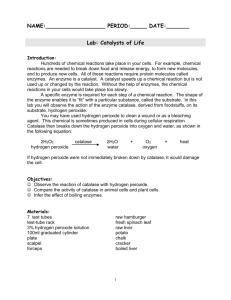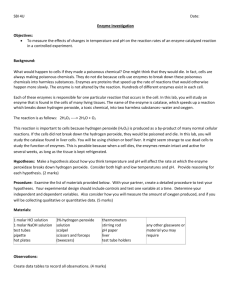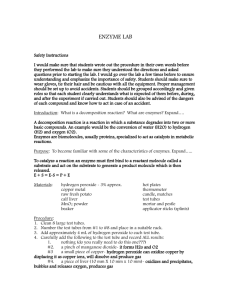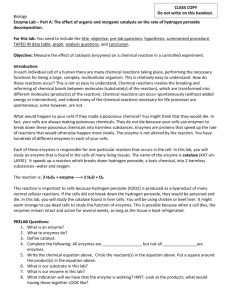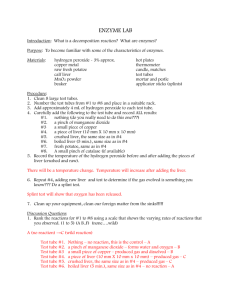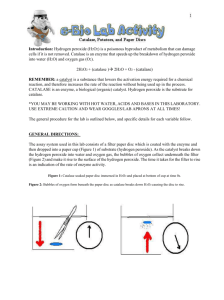Introduction Lab to the Enzyme Catalase
advertisement
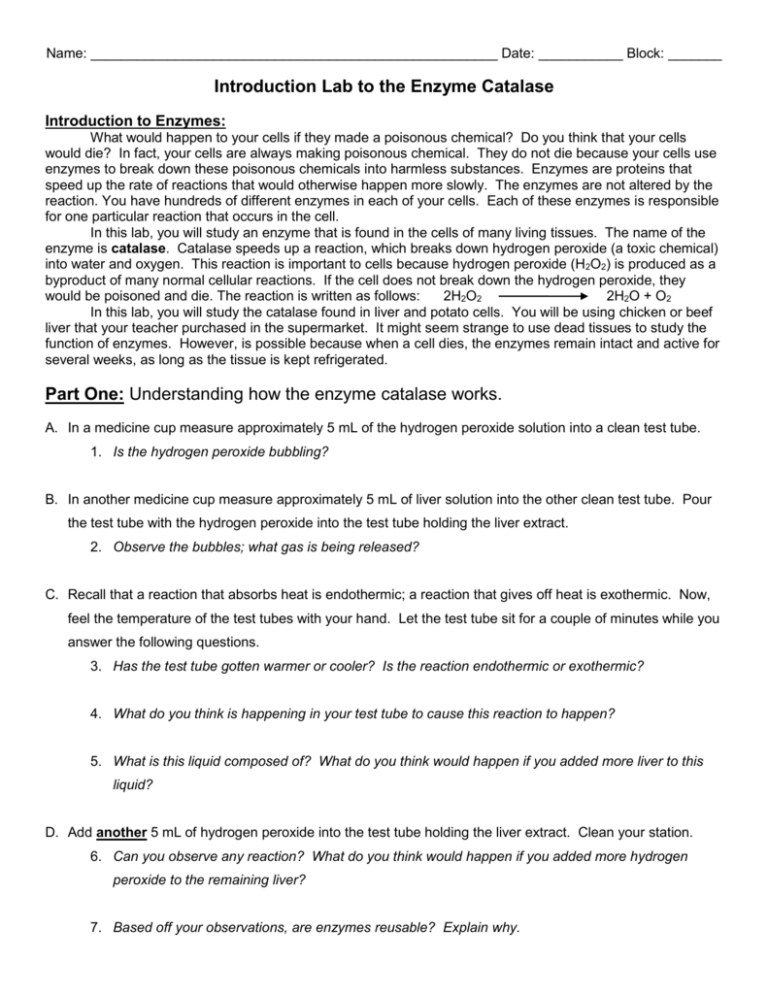
Name: _____________________________________________________ Date: ___________ Block: _______ Introduction Lab to the Enzyme Catalase Introduction to Enzymes: What would happen to your cells if they made a poisonous chemical? Do you think that your cells would die? In fact, your cells are always making poisonous chemical. They do not die because your cells use enzymes to break down these poisonous chemicals into harmless substances. Enzymes are proteins that speed up the rate of reactions that would otherwise happen more slowly. The enzymes are not altered by the reaction. You have hundreds of different enzymes in each of your cells. Each of these enzymes is responsible for one particular reaction that occurs in the cell. In this lab, you will study an enzyme that is found in the cells of many living tissues. The name of the enzyme is catalase. Catalase speeds up a reaction, which breaks down hydrogen peroxide (a toxic chemical) into water and oxygen. This reaction is important to cells because hydrogen peroxide (H2O2) is produced as a byproduct of many normal cellular reactions. If the cell does not break down the hydrogen peroxide, they would be poisoned and die. The reaction is written as follows: 2H2O2 2H2O + O2 In this lab, you will study the catalase found in liver and potato cells. You will be using chicken or beef liver that your teacher purchased in the supermarket. It might seem strange to use dead tissues to study the function of enzymes. However, is possible because when a cell dies, the enzymes remain intact and active for several weeks, as long as the tissue is kept refrigerated. Part One: Understanding how the enzyme catalase works. A. In a medicine cup measure approximately 5 mL of the hydrogen peroxide solution into a clean test tube. 1. Is the hydrogen peroxide bubbling? B. In another medicine cup measure approximately 5 mL of liver solution into the other clean test tube. Pour the test tube with the hydrogen peroxide into the test tube holding the liver extract. 2. Observe the bubbles; what gas is being released? C. Recall that a reaction that absorbs heat is endothermic; a reaction that gives off heat is exothermic. Now, feel the temperature of the test tubes with your hand. Let the test tube sit for a couple of minutes while you answer the following questions. 3. Has the test tube gotten warmer or cooler? Is the reaction endothermic or exothermic? 4. What do you think is happening in your test tube to cause this reaction to happen? 5. What is this liquid composed of? What do you think would happen if you added more liver to this liquid? D. Add another 5 mL of hydrogen peroxide into the test tube holding the liver extract. Clean your station. 6. Can you observe any reaction? What do you think would happen if you added more hydrogen peroxide to the remaining liver? 7. Based off your observations, are enzymes reusable? Explain why. Part Two: How does the type of Tissue affect Catalase Reaction Rates? Materials: -flask -tubing -glass dropper tube -stopper -100 mL graduated cylinder -calibrated medicine cups -tub -water -potato and liver enzyme solution -Hydrogen Peroxide (H2O2) Pre-Lab Preparation Experiment Enzyme Substrate Product(s) Potato Solution Liver Solution Hypothesis: (If/Then/Because): _____________________________________________________________ ________________________________________________________________________________________ ________________________________________________________________________________________ Null Hypothesis: There is no significant difference in the rate of reaction between the catalase found in the potato solution and the catalase found in the liver solution. Procedure: 1. 2. 3. 4. 5. 6. 7. 8. 9. In a medicine cup measure 20 mL of hydrogen peroxide (diluted with water by 50 percent). In a second medicine cup collect 10 mL of the potato enzyme solution. Fill a container ¾ full of water and submerge a 100 mL graduated cylinder in the water. Place the rubber tubing into the submerged graduated cylinder (keeping the mouth of the graduated cylinder under the water) invert the cylinder. Make sure the cylinder is full of water-no air pockets at the top. Pour the hydrogen peroxide and catalase solutions into the flask, quickly place the stopper on the flask and swirl. Begin timing when the first bubble of gas appears in the cylinder. Collect the amount of water displacement (mL) over time (sec) in the chart below. Repeat steps 1 through 7 using the liver extract solution. Repeat the experiment two times for each solution. Data Table: Amount of O2 Produced (mL/sec) Trial 1 2 Average: Catalase found in Potato Catalase found in Liver Line Graph: Include a title; label your x axis and y axis, and make two bars representing the averages. Possible Research Questions: Concept Map Aspects that affect the enzyme catalases rate of reaction? Part Three: Coming Up With an Enzyme Research Question Assignment: You and your team will design an experiment that investigates one aspect that affects enzyme catalases activity. You are allowed to work with 3 to 4 individuals to create a research question. You may turn in one copy of the materials/procedures per group. It may be hand written. Your teacher will meet with each group to quickly to review the materials and procedures. Remember that you will be responsible for obtaining any materials that are not commonly found in the classroom. Research Question: ________________________________________________________________ ________________________________________________________________________________ Hypothesis: (If/Then/Because): ______________________________________________________________ ________________________________________________________________________________________ ________________________________________________________________________________________ Null Hypothesis: _________________________________________________________________________ ________________________________________________________________________________________ ________________________________________________________________________________________ The materials and procedures will be due on: October 29th (B-day) and 30th (A-day) MATERIAL: your materials list should include the items listed below. - Be very specific - Do NOT number items - Size and number of each item listed - All measurements in METRIC units PROCEDURES: your procedures should include all of the items listed below. - Numbered steps - Each action should be written as a different step (Do not write in paragraph form). - Write your procedures so that it can be reproduced exactly - Be very specific- include equipment used in that step - Procedure steps include an exact description of how measurements will be taken - Do NOT write in 1st person (no you, I, we) - Include enough repeat trails (several, one won’t do) - Identify a control (if there is one) - Include diagrams if necessary - No vague statements The data collection will be on: October 31st (B-day) and September 1st (A-day) Please make sure to bring all the material that you will need that day. It will be the only block of class given to collect the data. The rest will need to be done before or after school based off the teacher availability.




